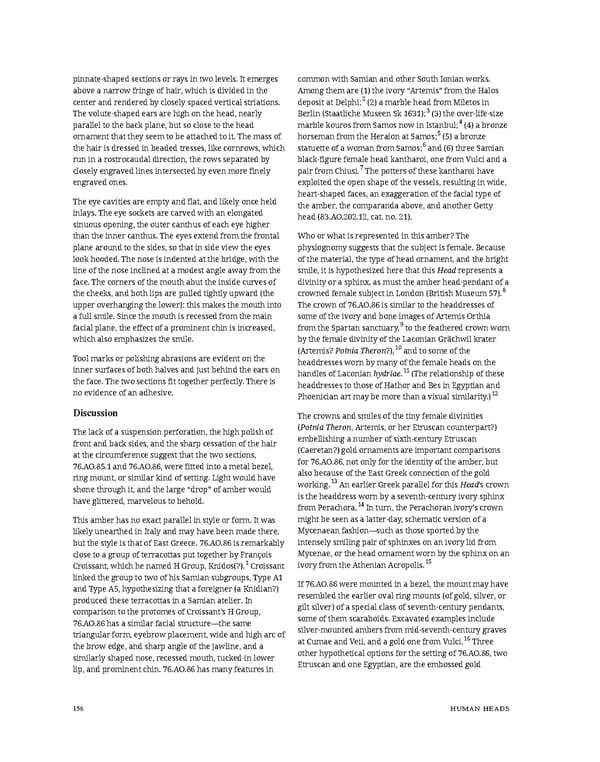pinnate-shaped sections or rays in two levels. It emerges common with Samian and other South Ionian works. above a narrow fringe of hair, which is divided in the Among them are (1) the ivory “Artemis” from the Halos center and rendered by closely spaced vertical striations. deposit at Delphi;2 (2) a marble head from Miletos in The volute-shaped ears are high on the head, nearly Berlin (Staatliche Museen Sk 1631);3 (3) the over-life-size parallel to the back plane, but so close to the head marble kouros from Samos now in Istanbul;4 (4) a bronze ornament that they seem to be attached to it. The mass of horseman from the Heraion at Samos;5 (5) a bronze the hair is dressed in beaded tresses, like cornrows, which statuette of a woman from Samos;6 and (6) three Samian run in a rostrocaudal direction, the rows separated by black-figure female head kantharoi, one from Vulci and a closely engraved lines intersected by even more finely pair from Chiusi.7 The potters of these kantharoi have engraved ones. exploited the open shape of the vessels, resulting in wide, heart-shaped faces, an exaggeration of the facial type of The eye cavities are empty and flat, and likely once held the amber, the comparanda above, and another Getty inlays. The eye sockets are carved with an elongated head (83.AO.202.12, cat. no. 21). sinuous opening, the outer canthus of each eye higher than the inner canthus. The eyes extend from the frontal Who or what is represented in this amber? The plane around to the sides, so that in side view the eyes physiognomy suggests that the subject is female. Because look hooded. The nose is indented at the bridge, with the of the material, the type of head ornament, and the bright line of the nose inclined at a modest angle away from the smile, it is hypothesized here that this Head represents a face. The corners of the mouth abut the inside curves of divinity or a sphinx, as must the amber head-pendant of a the cheeks, and both lips are pulled tightly upward (the crowned female subject in London (British Museum 57).8 upper overhanging the lower): this makes the mouth into The crown of 76.AO.86 is similar to the headdresses of a full smile. Since the mouth is recessed from the main some of the ivory and bone images of Artemis Orthia facial plane, the effect of a prominent chin is increased, from the Spartan sanctuary,9 to the feathered crown worn which also emphasizes the smile. by the female divinity of the Laconian Grächwil krater (Artemis? Potnia Theron?),10 and to some of the Tool marks or polishing abrasions are evident on the headdresses worn by many of the female heads on the inner surfaces of both halves and just behind the ears on handles of Laconian hydriae.11 (The relationship of these the face. The two sections fit together perfectly. There is headdresses to those of Hathor and Bes in Egyptian and no evidence of an adhesive. Phoenician art may be more than a visual similarity.)12 Discussion The crowns and smiles of the tiny female divinities The lack of a suspension perforation, the high polish of (Potnia Theron, Artemis, or her Etruscan counterpart?) front and back sides, and the sharp cessation of the hair embellishing a number of sixth-century Etruscan at the circumference suggest that the two sections, (Caeretan?) gold ornaments are important comparisons 76.AO.85.1 and 76.AO.86, were fitted into a metal bezel, for 76.AO.86, not only for the identity of the amber, but ring mount, or similar kind of setting. Light would have also because of the East Greek connection of the gold working.13 An earlier Greek parallel for this Head’s crown shone through it, and the large “drop” of amber would is the headdress worn by a seventh-century ivory sphinx have glittered, marvelous to behold. from Perachora.14 In turn, the Perachoran ivory’s crown This amber has no exact parallel in style or form. It was might be seen as a latter-day, schematic version of a likely unearthed in Italy and may have been made there, Mycenaean fashion—such as those sported by the but the style is that of East Greece. 76.AO.86 is remarkably intensely smiling pair of sphinxes on an ivory lid from close to a group of terracottas put together by François Mycenae, or the head ornament worn by the sphinx on an Croissant, which he named H Group, Knidos(?).1 Croissant ivory from the Athenian Acropolis.15 linked the group to two of his Samian subgroups, Type A1 If 76.AO.86 were mounted in a bezel, the mount may have and Type A5, hypothesizing that a foreigner (a Knidian?) resembled the earlier oval ring mounts (of gold, silver, or produced these terracottas in a Samian atelier. In gilt silver) of a special class of seventh-century pendants, comparison to the protomes of Croissant’s H Group, some of them scaraboids. Excavated examples include 76.AO.86 has a similar facial structure—the same silver-mounted ambers from mid-seventh-century graves triangular form, eyebrow placement, wide and high arc of at Cumae and Veii, and a gold one from Vulci.16 Three the brow edge, and sharp angle of the jawline, and a other hypothetical options for the setting of 76.AO.86, two similarly shaped nose, recessed mouth, tucked-in lower Etruscan and one Egyptian, are the embossed gold lip, and prominent chin. 76.AO.86 has many features in 156 HUMAN HEADS
 Ancient Carved Ambers in the J. Paul Getty Museum Page 165 Page 167
Ancient Carved Ambers in the J. Paul Getty Museum Page 165 Page 167